SlickLight-C is a new innovative design of downhole well intervention cable combining the flexibility of the traditional slickline with real-time downhole tool for management and communication, offering mechanical strength and features to cater traditional slickline services. The electrical conductor provides bi-directional telemetry and power delivery for the downhole tools.
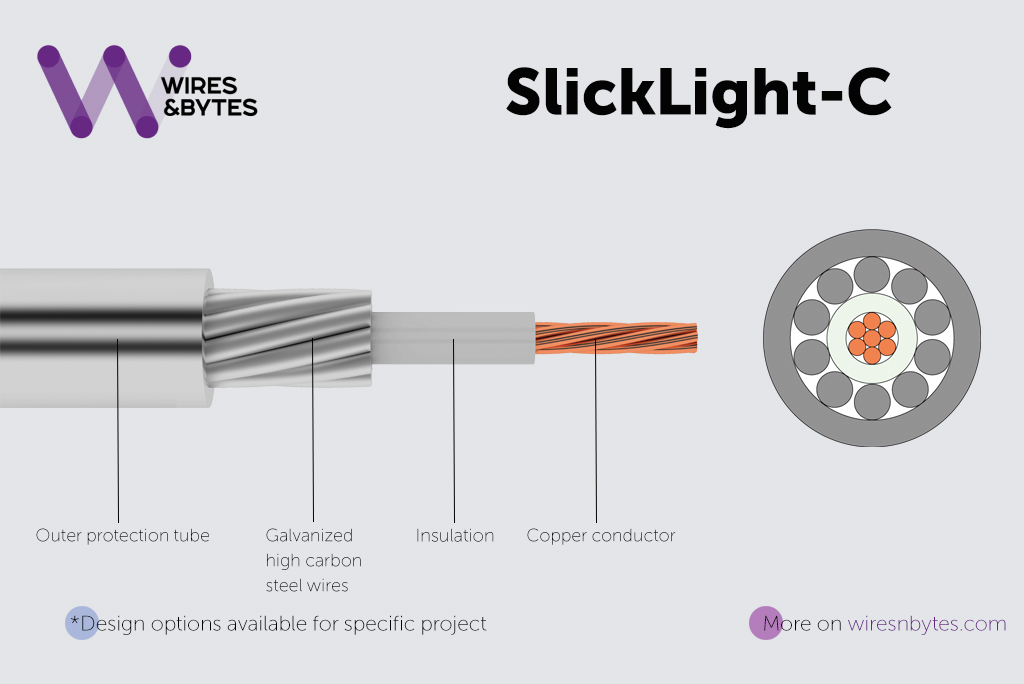
Application:
Provides power to and signals transmission from downhole tools
Key features:
Benefits:
Proven in live field applications: if you use SlickLight, data management and data decimation for DFOS can be fast. It does not even matter where you are: directly on the wellsite or remotely in the office.
Decimation, or reduction of data, is particularly important for Distributed Acoustic Sensing. When it comes to DAS, the application turns SlickLight cable into a vast number of “microphones”. Can you imagine an orchestra of 500 or even 1000 musical instruments playing together while music is being recorded, processed and visualized simultaneously and in real-time? Well, DFOS data analytics can. Moreover, when this “orchestra” performs, it produces a huge amount of data that needs to be handled, visualized, and documented. It can be a real challenge.
When using decimation techniques, the analyst can easily select the relevant data and scrap the rest. This helps to reduce the amount of data while retaining all the information and makes managing the quick on-site visualization and interpretation possible. Moreover, SlickLight data acquisition requires a small number of people physically present at the wellsite. Uploading decimated data to the cloud allows office workers and remote experts to have online insight as well which is enormously helpful when teams may be scattered across the globe but need to make good decisions together based on relevant data.
In September Wires&Bytes is organizing two webinars to discuss SlickLight technology and DFOS solution to understand the wellbore problems. The presenters will discuss how to maximize the real-time well intelligence while reducing time and costs, empowering the well owners and service companies to make decisions on site in real time. SlickLight, a key component of this solution, will allow customers to offer diagnostic intervention services using DTS/DAS.
Additionally, the webinar will include live Q&A session, so let’s turn it into a dialogue!
Presenters: Petar Basic and Michael Webster
Choose the time that suits you better and register:
September 15, 3:00 pm (CET) — REGISTER
September 17, 9:00 am (CET) — REGISTER
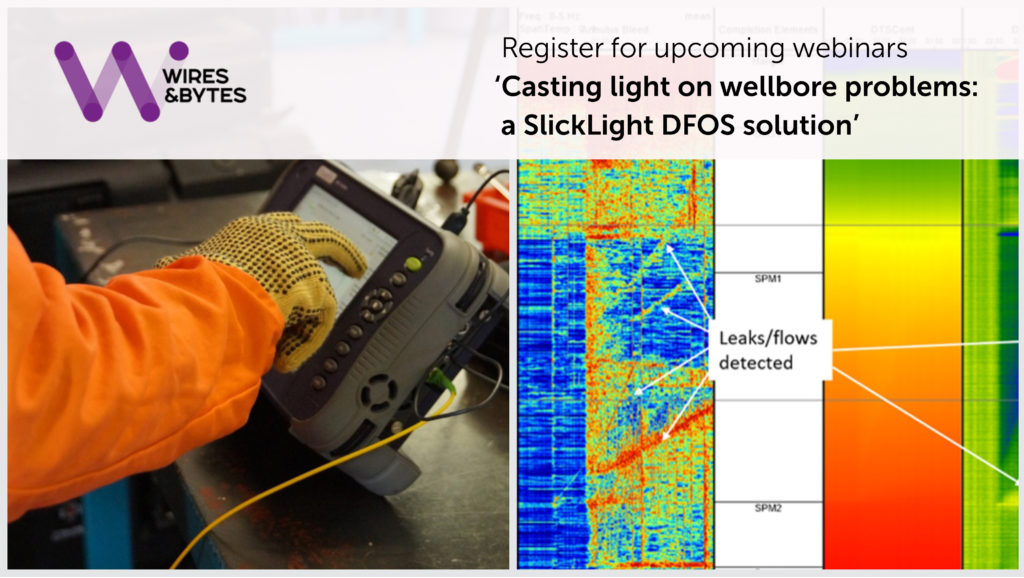
The United States has around 3 million miles of hazardous liquid, gas distribution, and gathering and transmission pipelines in operation, and more are being built every day.
According to the report of the Pipeline and Hazardous Materials Safety Administration, in 2020, there were 578 reported pipeline incidents in the United States, resulting in the death of 15 people, injuries to another 43, and about $340 million in damages. Leaks harm the environment severely causing water and soil pollution and devastating damage to flora and fauna. Keeping the data in mind, we should also remember that statistics can never capture the full force of tragedies.
Though modern technologies allow preventing measures in a very comprehensive way!
Pipeline integrity monitoring can be conducted using DFOS (temperature, acoustic, strain sensing). The fiber as a sensitive element can track the entire pipeline length. Thus the leaks, deformation processes, or unauthorized actions can be determined in real time and with higher accuracy.
Wires&Bytes offers a range of cables for pipeline integrity monitoring:
— UniSense (can be produced with a single or double stainless steel layer)
Also here’s the video example of how pipeline integrity monitoring system can be implemented
Contact us with the details of your project and we’ll offer the solution for you!
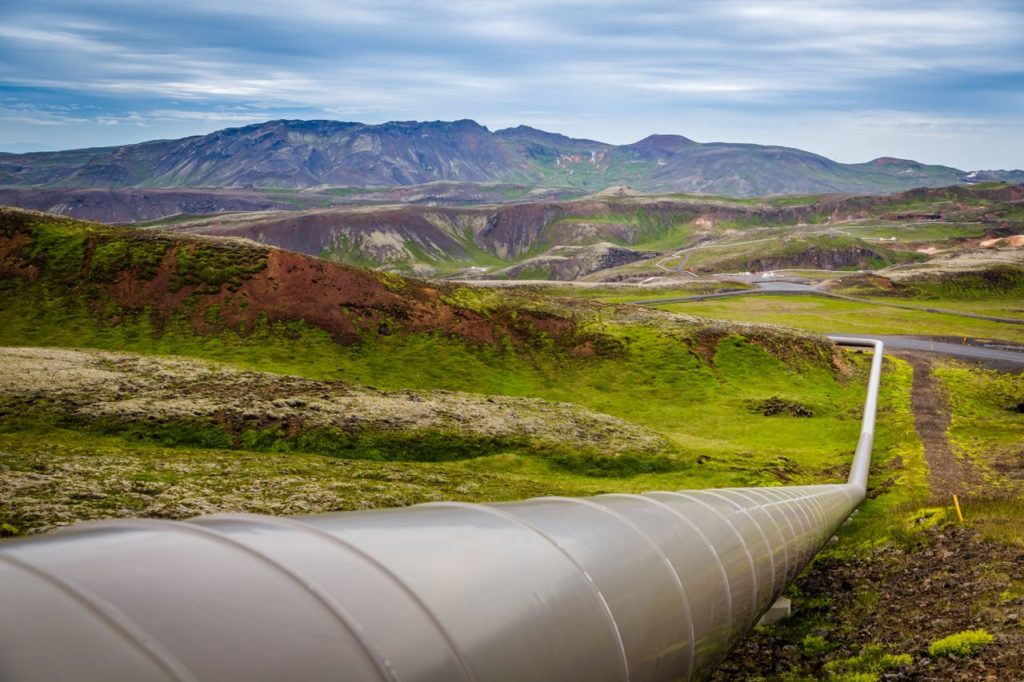
The use of geothermal energy is an important future energy supply issue within the global strategy of sustainable development. Water and/or steam carry the geothermal energy to the Earth’s surface. Depending on its characteristics, geothermal energy can be used for heating and cooling purposes or be harnessed to generate clean electricity.

Geothermal reservoirs offer unique monitoring and characterization challenges. One of the serious problems with the use of geothermal water/steam is changes in temperature and pressure. It influences the equilibrium and leads to the scale formation on the wall surface of wells, flow lines, valves, turbines, etc. The harsh, high temperature downhole environment requires robust measurement technology with advanced features. And this is where fiber optic sensors can be utilized as a helpful tool for the application in geothermal wells! Remote operation, small sizes and robust design are being of particular importance and among the inherent advantages.
Over the past decade DFOS has evolved from a new to a prominent geophysical tool with still ever-expanding applications. This is extremely useful to measure continuous temperature and pressure profiles in the subsurface for geothermal exploration. Both DTS and DAS, and even DSS features can be integrated into a single cable design and conduct multiple fully independent measurements simultaneously thus providing independent data for the same perturbation. Using the same design and one time installation for acquisition of different data brings economic benefits for the operators.
Data received from fiber optic sensors can be used in defining the intensity of the thermal anomalies and setting a long-term monitoring system that enables transferring geothermal energy more effectively.
Among the designs offered by Wires&Bytes SensoWire, SlickLight and MultiSense can be used for geothermal monitoring. SensoWire is more traditional and suitable for DTS and DAS applications whereas MultiSense and SlickLight are more innovative and raising significant interest in the industry, providing various asset health monitoring applications. In terms of geothermal monitoring MultiSense can be exploited for acoustic, seismic and well structural health monitoring using its DSS feature (to monitor the integrity of the wells). Currently MultiSense is being deployed and trialed in the geothermal well in Germany. Stay tuned for updates!
In early July one of the Wires&Bytes brand-new designs — Non-Metallic MultiSense — passed the climatic test successfully and confirmed its operation temperature range from -60°C to +85°C.
The test lasted for 6 hours, and the cable withstood 3 cycles of exposure to temperatures from -60°C to +85°C. This potentially means that Non-Metallic MultiSense can be used in different environments having almost no restrictions in outdoor installations. Particularly the cable can be buried in the ground or integrated into structures such as roads, concrete beams and slabs and withstand sub-zero temperatures while providing quality strain temperature and acoustic acquisition data.
This time the cable samples were wound on a plywood spool. The second step of the planned climatic tests will be conducted with a coil of a cable. We’ll keep you posted on results!

Non-metallic MultiSense is a design with a gel-filled central PBT loose tube with optical fibers freely placed inside with 4 tight-buffered optical fibers, FRP rods, and outer jacket suitable for all types of DFOS systems and distributed monitoring as well as for simultaneous multiple measurements along with fibers for data communication. Learn more
Also dig for:
Structural health monitoring systems aim to provide information about any significant change or damage occurring in a structure. The key purpose of structural damage detection is to identify the reason, location, and type of damage, and then to measure the damage severity and predict the structure’s service life and behavior. Different types of structural defects can be caused by internal factors (corrosion, fatigue, ageing, etc.) and external factors (earthquakes, wind loads, soil movements, etc.). Any type of defect may lead to collapses.
One may say that nothing is eternal, but when it comes to the pieces of Ancient and Medieval architecture, science and technology must be as innovative as possible in terms of preserving cultural heritage for future generations. And here comes the fiber optic technology that offers DFOS monitoring. Understanding the structural behavior of heritage buildings is usually a very complicated task because they typically present complex deterioration and damage patterns.
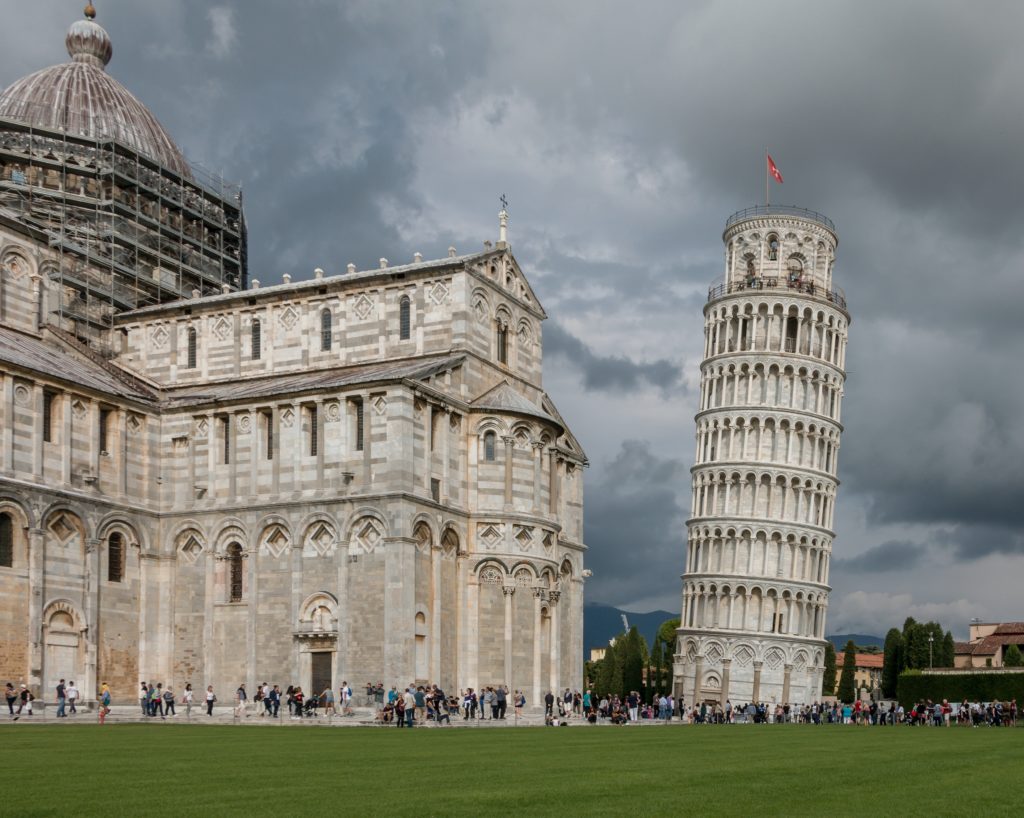
So let’s take a look, for example, at The Leaning Tower of Pisa. The Tower of Pisa, which is the bell tower of the city’s Cathedral, began tilting during its construction in the 12th century, due to an inadequate foundation on the ground that was too soft to properly support the structure’s weight (there used to be a river in the area; the name Pisa is Greek for ‘marshy land’). The tilt increased in the decades before the structure was completed in the 14th century.
The Leaning Tower of Pisa was stabilized with a massive engineering operation that took place in the 1990s and lasted over a decade, in the attempt to stop the monument from falling. In fact, by the end of the 1980s, the Tower was slowly heading toward its catastrophic collapse.
The solution to this problem was found in reinforcing the soil under the foundation and making room for the Tower to compress some of the soil and straighten back up towards the North (the Tower leans to the South). In theory, it would be possible to straighten it completely, but nobody really wanted that. The Tower was born leaning and should have remained leaning.
And to keep this leaning safe in the future the Tower needs continuous surveying to assess its stability. With the help of structural health monitoring, let’s say! DFOS monitoring can track and record both soil movements and the monument behavior horizontally and vertically all along the cable length. MultiSense is the perfect solution in this case as it is extremely sensitive and can provide loads of useful data to a monitoring specialist and data analyst.

SlickLight-C is a new design of downhole well intervention cable, which combines the flexibility and mechanical strength comparable to traditional slickline with real-time downhole electrical tool management and communication with use of central electrical high temperature conductor offering both bidirectional high-speed telemetry and power delivery.
The small round-shape slickline design offers low friction and low abrasion with no need for expensive grease and pressure control equipment on the well site. The standard slickline dual pack-off pressure control equipment is all you need. The central conductor is a stranded type. This stranding works in conjunction with the upper steel round wire stranding for a better bending performance and a longer lifetime. Various types of polymers can be applied on top of the copper wire strand, with 200°C Fluorinated Ethylene Propylene (FEP) being the standard option.
The stranded steel wire layer and the final round outer steel tube define the mechanical performance of the overall construction. The low-footprint design aims to offer high-speed communication, fast battery charging and electrical powering of logging and downhole equipment.
The innovative SlickLight-C technology is bridging the gap between a cased-hole electric line and standard slickline services and represents a further step towards real-time full-length logging and profiling. This technology empowers the users to make immediate decisions at the well site, while performing both electrical and mechanical services.
𝘎𝘦𝘵 𝘪𝘯 𝘵𝘰𝘶𝘤𝘩 𝘵𝘰𝘥𝘢𝘺 & 𝘸𝘦 𝘸𝘪𝘭𝘭 𝘣𝘦 𝘢𝘣𝘭𝘦 𝘵𝘰 𝘢𝘥𝘷𝘪𝘴𝘦, 𝘴𝘶𝘱𝘱𝘭𝘺, 𝘪𝘯𝘴𝘵𝘢𝘭𝘭 𝘢𝘯𝘥 𝘴𝘶𝘱𝘱𝘰𝘳𝘵 𝘺𝘰𝘶𝘳 𝘰𝘱𝘵𝘪𝘮𝘢𝘭 𝘴𝘰𝘭𝘶𝘵𝘪𝘰𝘯.
At Wires&Bytes we are constantly moving forward with our designs, while also taking into consideration multiple different aspects of what our production should include. Nowadays, when the issue of environmental protection is as acute as ever, we would like to share the ideas of our contribution to this key element.
Going green means being efficient
The newest development – thick-wall SlickLight is going to change the way things are organized on well sites. While keeping the size of the SlickLight the same as traditional slicklines, and back-compatible with traditional and standard equipment, it will use the cross-section of the SlickLight more efficiently and increase the tensile strength. This applies to all SlickLight products: copper-only, fiber optic only, and hybrid, having copper and fiber optic together.
Furthermore, with the increased working strength it will be possible to provide data acquisition for deeper wells using slickline technology.
These factors contribute to lower fuel and energy consumption and fewer emissions for well intervention jobs. The operators will be able to achieve more with the same equipment and resources on the well site. It takes modern production technology to combine efficiency in operations, environmental protection, and the acquisition of quality data.
The new line will be commissioned this autumn. For now, you can check out the beauty of the current production line.
Fiber optic based technology can be used as an unmatched tool for monitoring, detecting and analyzing the deformation in soil slopes or any type of ground movement during the pre-failure stage. It is crucial to monitor hazard-prone regions to save human lives and assets. The effectiveness and sensitivity of DFOS technology are promising for possible use as a reliable early warning and forecasting system. Also, it can play a crucial role in the construction and post-construction period of engineering projects such as tunnels, pipelines, bridges, or open road cuts.
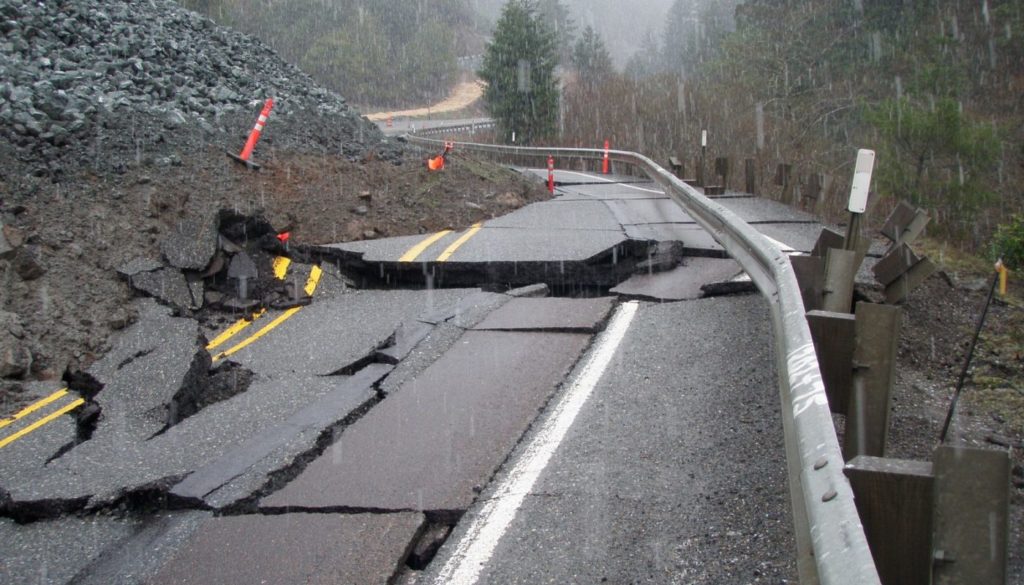
Exploiting its high spatial detection range (up to 2 km of fiber length) the sensor cable can be deployed all across the potentially unstable areas even when their location is not known apriori, and to measure the displacement of the unstable soil mass with respect to the stable ground along the cable length. Thanks to its high sensitivity and spatial resolution, the sensor cable can detect and monitor the development of small strain within the ground movement.
Wires&Bytes offers a number of cables that serve for detection of slope or ground movements such as Non-metallic MultiSense, UniTEF, or CreepGuard.

MultiSense product fits well to this application as it combines strain-coupled and strain-free fiber configuration. Strain sensing fibers in the armor layer can be stranded to the customer specified helix lay-length, tuning the strain sensitivity of the cable and customizing it to a magnitude, exceeding the physical possibilities of uncabled optical fibers. For strain values beyond 1% we recommend considering the deployment of loose tubes in the armor layer. For all the other strain rates equal or lower than 0.15%, the central loose tube will be needed for temperature compensation or for organizing the loop for stimulated Brillouin scattering interrogation.
Further, its unique feature of pressure-strain transduction, MutiSense cable is acoustically very sensitive to pressure changes in the environment, in this case with the soil in which it is deployed. This feature needs only 1 single-mode fiber in the stranded layer, and it will provide even more useful data to a monitoring specialist and data analyst, which will be unprecedented and critical for future decisions. Both in the lab and in the industry MultiSense has been proven to exhibit high seismic sensitivity using standard telecommunication fibers only and this contributes to the cost efficiency in the projects. The sensitivity is comparable with Rayleigh backscatter enhanced optical fibers and it can be extensively used when the cable is deployed in the soil for various and independent data acquisition.
Explore relevant fiber optic cables on our website
𝘎𝘦𝘵 𝘪𝘯 𝘵𝘰𝘶𝘤𝘩 𝘵𝘰𝘥𝘢𝘺 & 𝘸𝘦 𝘸𝘪𝘭𝘭 𝘣𝘦 𝘢𝘣𝘭𝘦 𝘵𝘰 𝘢𝘥𝘷𝘪𝘴𝘦, 𝘴𝘶𝘱𝘱𝘭𝘺, 𝘪𝘯𝘴𝘵𝘢𝘭𝘭 𝘢𝘯𝘥 𝘴𝘶𝘱𝘱𝘰𝘳𝘵 𝘺𝘰𝘶𝘳 𝘰𝘱𝘵𝘪𝘮𝘢𝘭 𝘴𝘰𝘭𝘶𝘵𝘪𝘰𝘯!
Picture credit: Oregon Department of Transportation